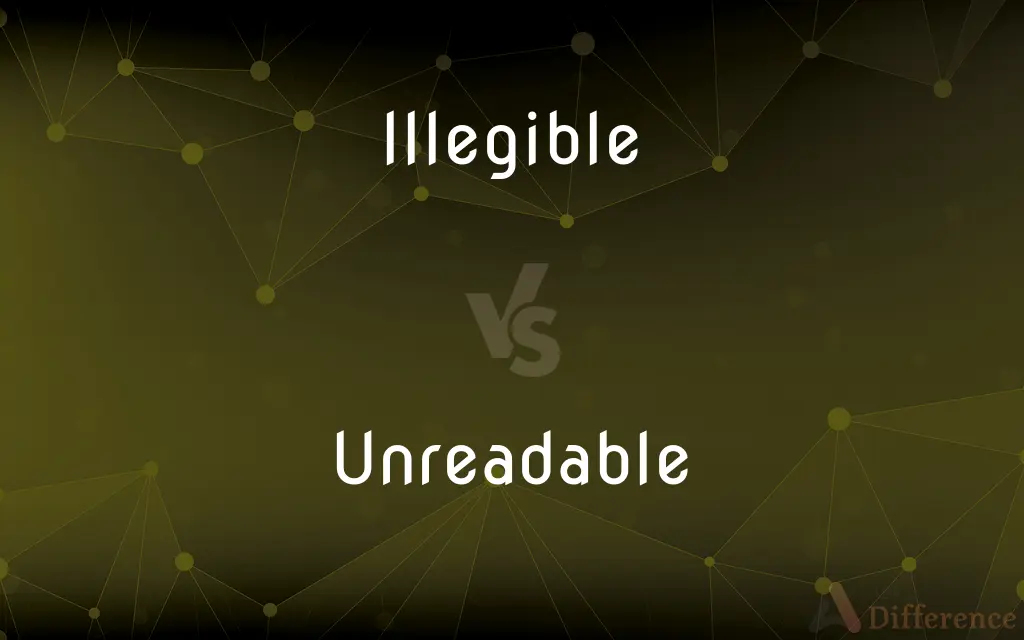Illegible vs. Unreadable — What's the Difference?
Edited by Tayyaba Rehman — By Fiza Rafique — Updated on April 28, 2024
Illegible writing is difficult to decipher due to poor handwriting or faint print, while unreadable text can be due to complexity or dullness in content.

Difference Between Illegible and Unreadable
Table of Contents
ADVERTISEMENT
Key Differences
Illegible text refers to physical text characteristics that hinder readability, such as bad handwriting or smudged print, making it hard to make out the letters or words. On the other hand, unreadable text can stem from the content's complexity or verbosity, where the difficulty lies not in the visual presentation but in the text's comprehensibility or engagement level.
Illegible script often results from hurried, carelessly done, or stylistically obscure handwriting. Whereas unreadable text might be well-formed and clear in its print quality but uses jargon, convoluted sentence structures, or overly abstract concepts that make understanding challenging.
Issues with illegibility are primarily visual and can sometimes be remedied by improving the physical quality of the text, like adjusting the print quality or rewriting a note more neatly. In contrast, making text more readable often requires revisions to the content itself, such as simplifying language, clarifying ideas, or organizing the text more logically.
While dealing with illegible text, one usually knows that meaningful content exists but accessing it is physically obstructed. Conversely, with unreadable text, the barrier is intellectual, as the words are clear but the meaning or engagement is obscured or absent.
In practice, illegibility is a common issue in handwritten notes, doctor's prescriptions, or ancient manuscripts, where physical characteristics interfere with reading. Unreadable text, however, is often encountered in academic papers, legal documents, or technical manuals, where the style of writing detracts from its accessibility.
ADVERTISEMENT
Comparison Chart
Definition
Hard to read due to poor handwriting or print quality.
Hard to understand due to complex or dull content.
Main Issue
Physical clarity of text.
Comprehensibility or engagement of content.
Common Causes
Bad handwriting, smudging, faint printing.
Jargon, complex sentence structure, lack of coherence.
Solutions
Improve handwriting, enhance print quality.
Simplify language, clarify ideas, organize better.
Typical Contexts
Handwritten notes, old manuscripts.
Academic articles, legal documents, technical manuals.
Compare with Definitions
Illegible
Unreadable due to physical damage.
Water damage rendered the document illegible.
Unreadable
Filled with jargon or technical terms.
The legal document was unreadable for those outside the legal profession.
Illegible
Not clear enough to be read.
The signature was illegible, just a scribble on paper.
Unreadable
Lacking logical coherence.
His argument was unreadable, jumping from one idea to another.
Illegible
Lacking distinctness in letter formation.
Her rushed handwriting was almost illegible.
Unreadable
Not easily understood because of complexity.
The textbook was unreadable for beginners due to its advanced terminology.
Illegible
Difficult to read due to faint printing.
The printer was low on ink, making the text illegible.
Unreadable
Boring or not engaging.
The manuscript was unreadable despite its clear typeface.
Illegible
Hard to read because of poor handwriting.
His notes were so illegible that no one else could decipher them.
Unreadable
Difficult to maintain interest in.
The article was unreadable, filled with endless statistics.
Illegible
Not clear enough to be read
His handwriting is totally illegible
Unreadable
Not clear enough to read; illegible
Unreadable handwriting
Illegible
Not legible or decipherable.
Unreadable
(of data or a storage medium or device) not capable of being processed or interpreted by a computer or other electronic device.
Illegible
Not clear enough to be read; unreadable; not legible or decipherable.
Unreadable
Not legible or decipherable; illegible
Unreadable handwriting.
Illegible
Incapable of being read; not legible; as, illegible handwriting; an illegible inscription.
Unreadable
Unsuitable for or not worth reading
Unreadable prose.
Illegible
(of handwriting, print, etc.) not legible;
Illegible handwriting
Unreadable
Not interesting; dull
Wholly unreadable statistics.
Unreadable
Incomprehensible; opaque
An unreadable facial expression.
Unreadable
That cannot be read or is not easy to read.
Unreadable handwriting
A machine that cut up secret documents into small unreadable fragments
Unreadable charts
Unreadable
Not sufficiently interesting to be worth reading.
Unreadable books
Unreadable
Not able to be read—i.e. accessed or played—by some technical device.
The scratched CD is unreadable.
Unreadable
Not easily deciphered;
Indecipherable handwriting
Common Curiosities
What is the main difference between illegibility and unreadability in digital texts?
In digital texts, illegibility can arise from issues like low resolution or poor contrast, whereas unreadability often stems from poor content structure or language use.
What impact does paper quality have on legibility?
Poor paper quality can cause ink to spread or paper to smudge, contributing to illegibility.
How can you tell if a text is illegible or just difficult to read?
A text is considered illegible if most people cannot discern the letters or words due to physical reasons like poor handwriting or printing.
What tools can help improve the legibility of handwritten notes?
Tools like darker pens, lined paper, or digital apps that enhance handwriting can improve legibility.
Can lighting conditions affect text legibility?
Yes, poor lighting can make even well-written text appear illegible by obscuring visibility.
Are certain fonts or styles more prone to illegibility?
Yes, overly stylized or very small fonts can render text illegible by making characters hard to distinguish.
Can unreadable text be legally problematic?
Yes, if critical information in legal or official documents is unreadable, it can lead to misunderstandings or non-compliance issues.
What are some examples of when illegibility is a deliberate choice?
Artists or designers may use illegible text to create a specific visual impact or convey chaos and confusion in their work.
How do language barriers play into the concept of unreadability?
Text in a highly technical or unfamiliar language can be considered unreadable if it prevents comprehension, regardless of the clarity of its presentation.
Are there educational impacts of unreadable textbooks or materials?
Yes, unreadable educational materials can hinder learning, reduce engagement, and increase cognitive load on students.
What role do editors play in addressing unreadability?
Editors critically assess and revise text to improve clarity, coherence, and engagement, thereby addressing issues of unreadability.
Can a text be intentionally made unreadable or illegible?
Yes, sometimes text is made unreadable or illegible intentionally for artistic purposes or to obscure information.
How does the context of reading influence perceptions of unreadability?
The context, such as reading for leisure versus academic study, can influence how readable or engaging the content feels.
Is there a way to measure the degree of illegibility or unreadability in a text?
While subjective, certain standards and readability tests can measure aspects like sentence length and word difficulty to gauge readability, but measuring illegibility often relies more on consensus and visual assessment.
Can digital tools correct illegibility in historical documents?
Yes, digital tools and techniques like image enhancement and transcription software can help decipher and preserve illegible historical texts.
Share Your Discovery

Previous Comparison
Place vs. Put
Next Comparison
Dreamed vs. DreamtAuthor Spotlight
Written by
Fiza RafiqueFiza Rafique is a skilled content writer at AskDifference.com, where she meticulously refines and enhances written pieces. Drawing from her vast editorial expertise, Fiza ensures clarity, accuracy, and precision in every article. Passionate about language, she continually seeks to elevate the quality of content for readers worldwide.
Edited by
Tayyaba RehmanTayyaba Rehman is a distinguished writer, currently serving as a primary contributor to askdifference.com. As a researcher in semantics and etymology, Tayyaba's passion for the complexity of languages and their distinctions has found a perfect home on the platform. Tayyaba delves into the intricacies of language, distinguishing between commonly confused words and phrases, thereby providing clarity for readers worldwide.
















































